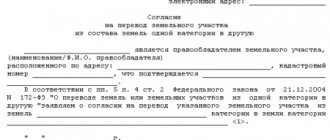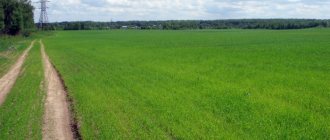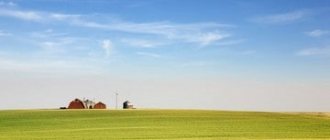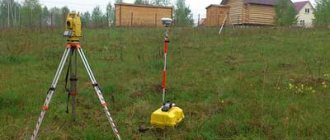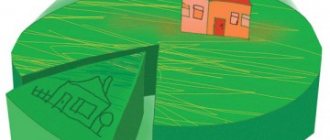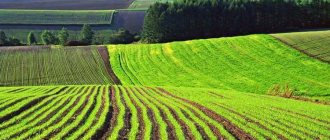Some general information
Land territories, as objects of legal relationships, are grouped into separate categories of land for more efficient use. Based on the legislation and due to its unique properties, the land plot is primarily positioned as a natural resource and only then as an option for ownership.
The concept of a land plot refers to a part of the land that has strict boundaries approved by documents. In this case, a separate part of the territory becomes not only one of the basic resources, but also part of civil law, in accordance with Article 130 of the Civil Code of the Russian Federation. At the same time, the state reserves the right to monitor the environmental condition and intended use of property.
The division of territories based on Art. 7-8 of the RF Land Code are dealt with by the following government agencies:
- Government of the Russian Federation – governs territories of federal significance;
- executive authorities control areas that are part of the constituent entities of the Russian Federation;
- Local government bodies monitor the condition of all other categories of land.
A plot as real estate can consist of several plots or be formed thanks to previously unused territories from the municipal or state balance.
Russia is a huge country and care for each specific territory is entrusted to local government
Features of farmland
Farmland has a number of features compared to other types of farmland. They are enshrined in law (Article 79 of the Land Code of the Russian Federation).
- The most fertile lands are under state protection, as they are its national treasure and most important resource.
- Such lands can be used only for their intended purpose, that is, for agricultural activities. Inappropriate use is punishable by law .
- Farmland with a high cadastral value is not subject to transfer to other categories of land
- The construction of any types of buildings in areas protected by the state is prohibited.
In exceptional cases, in agreement with regional authorities, farmland with poorer soil quality and low cadastral value may be transferred to another category of land.
Among other things, the legislation establishes requirements for persons using farmland:
- the plots must be developed within 2 years,
- while carrying out its activities, maintain soil fertility,
- If necessary, provide authorities with information about the chemicals used.
List of categories of land plots
Each type of territory was created for the purpose of strategic conservation and exploitation of real estate resources that cannot be transferred in space.
Based on the properties that a piece of land has, possible forms of use are determined:
- agricultural - these include the most fertile areas that can be used for the production of agricultural products;
- forest – areas with dense vegetation cover;
- specially protected areas are lands that have unique ecological significance.
The legislative bodies of the Russian Federation, based on Article 7 3K, distinguish 7 categories of land territories:
- Agricultural purposes to support economic activities.
- Settlements as administrative units.
- Forest Fund.
- Water Balance Fund.
- Industry, transport, telecommunications, energy.
- Specially Protected Areas (SPAs) of significant ecological, historical, cultural or similar significance.
- The reserve to which the privatized plots belong.
Approximate ratio of the main categories of land plots
Let us dwell in more detail on each listed category of land plots.
Agricultural land
Article 77 of the Land Code of the Russian Federation states that the agricultural category includes territorial areas located outside the borders of administrative units and having appropriate use. In turn, legislators break this huge part of the land resource into subcategories, which include:
- lands with transport and communication infrastructure, forest plantations and similar objects that reduce the harmful impact on the area;
- land;
- territories intended for buildings for processing agricultural products;
- areas occupied by water resources in the form of artificial fire-fighting facilities or similar units.
The state protects land with fertility as a priority. These areas include:
- gardens;
- pastures for livestock;
- arable land;
- haymaking.
It is worth noting that Article 77 of the Land Code of the Russian Federation does not regulate the issue of determining the category of lands of gardening partnerships. However, the latter, being outside administrative points, are considered part of the category of agricultural land. A special feature of SNT is permission for both gardening and the creation of economic structures, according to Art. 19 Federal Law No. 66.
Agricultural land is an important part for the entire population of the Russian Federation
Specially protected areas
Based on Art. 94 of the Land Code this category includes lands with a specialized purpose. In most cases, such objects are withdrawn from civil circulation and are under state control in the SPA (specially protected area) regime. The law does not provide for a return exit from OOO to other categories.
Main groups of PAs:
- Medical and health facilities for treatment and prevention.
- Nature reserves, botanical gardens, national and natural reserves.
- Objects of historical and cultural heritage.
- Conservation lands of forests and other structures for the protection of environmental objects.
- Areas of recreational function: health and fitness, tourist areas.
Specially protected zones are ecologically clean areas
See also: Catalog of the most popular sites in the Moscow region for the construction of country houses.
Category of forest and water resources
The territories of the Russian Federation occupied by forest and water areas are collected into a separate type, which includes the following cases:
- forestry areas;
- lands related to revegetation;
- areas occupied by forest.
The Forest Planting Fund is a protected area and is regulated by the rules of the Forest Code of the Russian Federation. Private individuals become owners of plots of this category as an exception.
Based on Article 102 of the Land Code, areas occupied by surface natural waters and hydraulic structures are classified as water bodies. According to the Water Code, such lands are not divided into plots.
Areas covered with natural waters and with installed hydraulic structures are not divided into sections
Plots of land in populated areas
The lands of settlements (LNP) include areas allocated for construction activities and administrative and municipal work. ZNP as a category of land is separated from other groups by the approved boundaries of other settlements and rural areas that cannot cross the territory of neighboring territories, based on the master plan or territorial planning scheme.
Article 85 of the Land Code of the Russian Federation regulates zones that can be classified as ZNP:
- Social and business;
- Residential;
- Recreational;
- Agricultural;
- Special;
- Production;
- Engineering and transport infrastructure zones.
Urban planning regulations distribute this or that site into specific types of zones, with the assignment of special values, including for the land of populated areas, this means that residential development can be called marks like: Zh1, Zh4, Zh6. O, speaks of the attitude towards social and business affiliation, “I” - engineering structures, “P” - production.
Based on regulatory act No. 5 to the Order of the Federal Tax Service No. ММВ-7-21/347 dated May 10, 2017, the category of land must be indicated in the form of a special code.
Lands of populated areas can be divided into agricultural plots
Is it possible to convert land from agricultural production to horticulture?
This possibility is provided for by law, but in practice a number of restrictions arise. You will have to take into account the purposes of the future use of the site, the presence of real estate on it and other nuances. Before transferring land to horticulture, it is advisable to familiarize yourself with the Classifier of types of permitted use.
- If the site will be used for “Gardening on farmland” (clause 1.5), the construction of greenhouses and fences, the creation of wells is allowed here, but the construction of capital real estate is prohibited.
- If the land will be used for “Gardening” (clause 13.2), the Classifier allows the construction of real estate, outbuildings and the cultivation of various crops.
In the first case, the transfer of land from agricultural production is allowed if there are no warehouses on the site that were previously used for storing agricultural products, public catering facilities and other objects prohibited in areas with code 1.5.
In the second situation, there are no such restrictions, although here, too, the construction of certain real estate, which may be located on an agricultural production site, is not permitted.
- Before the transfer, the functional purpose of the objects will have to be changed, or prohibited buildings will have to be dismantled. Otherwise, the application will be denied.
- If a large part of the plot will be occupied by residential buildings or year-round living is planned, as well as under other conditions provided for by law, it is necessary that town planning regulations be approved for the territory (it will have to be included in the boundaries of settlements).
Additionally, you will need a draft site plan indicating the construction sites, as well as passageways in the area being formed. It is also necessary to approve a survey project demonstrating the total number and location of the land plots and public lands being formed.
Some restrictions relate to the presence of other owners, or the desire to organize a non-profit partnership. The land lawyers of our company will help you understand all the nuances of the procedure.
Purpose of land plots
In addition to the 7 categories of sites, the concept of intended purpose is used in the right field.
The purpose of a land plot is the form of land use agreed upon with the authorities within specific boundaries.
Forms of acceptable use:
- The main ones , which determine the main purpose of the land and are regulated in the Town Planning Regulations.
- Conditionally permitted . Legal activity requires approval from a special commission.
- Auxiliary . They are a clarifying addition for more optimal use of space.
The clarifying type of auxiliary VRI is relevant when placing a transformer booth, garage building, fence, etc. This will allow the developer to legally introduce the structure into the general purpose of the land plot.
Seizure
The legislation stipulates that the state has the right in some cases to forcibly confiscate agricultural land from the owner.
This decision is made in court and can be challenged within the appropriate period. The main reasons for the seizure of farmland:
- the agricultural plot has not been used for its intended purpose for three or more years,
- the site is used irrationally, which leads to a decrease in soil fertility and deterioration in the quality of agricultural land.
Video description
It doesn’t hurt to know about the possibility of changing the VRI, information in this video:
Peculiarities of the purpose of a private plot of land
Personal subsidiary plot (PHS) is a series of buildings created for agricultural activities. The owner of the plot must have confirmation of the right to the land through a documented transaction (purchase and sale, gift) or have papers on the transfer of the territory for use from the municipality.
Features of private household plots:
- The owner does not keep accounting records and is not a payer of taxes to the treasury due to the absence of activities aimed at making a profit.
- Only surplus products received are allowed to be sold.
- If entrepreneurial activity is carried out, the owner must not use hired labor.
- Private household plot is the documented purpose of land without alternatives.
It is worth noting that such plots can be located within urban areas, like a personal plot.
A plot of land for private household plots cannot be used for business activities
Redistribution Fund
The Land Redistribution Fund is a unified database of agricultural plots that have temporarily fallen out of circulation, that is, not used for their intended purpose.
Its main function is the formation of a fund of land and their further transfer for use to individuals or legal entities under certain conditions.
This is done so that strategically important farmland does not stand idle, because this is economically unprofitable.
An agricultural plot falls into the distribution fund under the following conditions :
- in case of voluntary refusal of the owner from the site,
- in the absence of heirs after the death of the owner,
- during forced seizure of land by the state.
Don’t know how to find out the category of your land plot?
If you know its cadastral number or location, read detailed instructions here.This article will help you decide on the category of site for construction.
Video description
Interesting information about the rules for developing land plots in SNT in the video:
Form of individual housing construction plot
According to the Town Planning Code of the Russian Federation, individual housing construction (IHC) is a detached house in which a family can live permanently without exceeding three floors of the building. At the same time, the need for communications (gas, water supply, electricity) remains with government agencies. This form of land ownership makes it possible to register.
Providing
Providing agricultural land for use essentially means transferring such land for rent for its intended use. In this case, the plots remain the property of the state.
To obtain a plot you must :
- Submit an application to the appropriate authority.
- Collect a package of documents.
- Wait for a decision.
- Conclude a lease agreement.
The law provides for a number of benefits and advantages when transferring agricultural land to certain categories of persons (for example, small peoples to support and preserve their way of life).
